By Andrew Beahrs
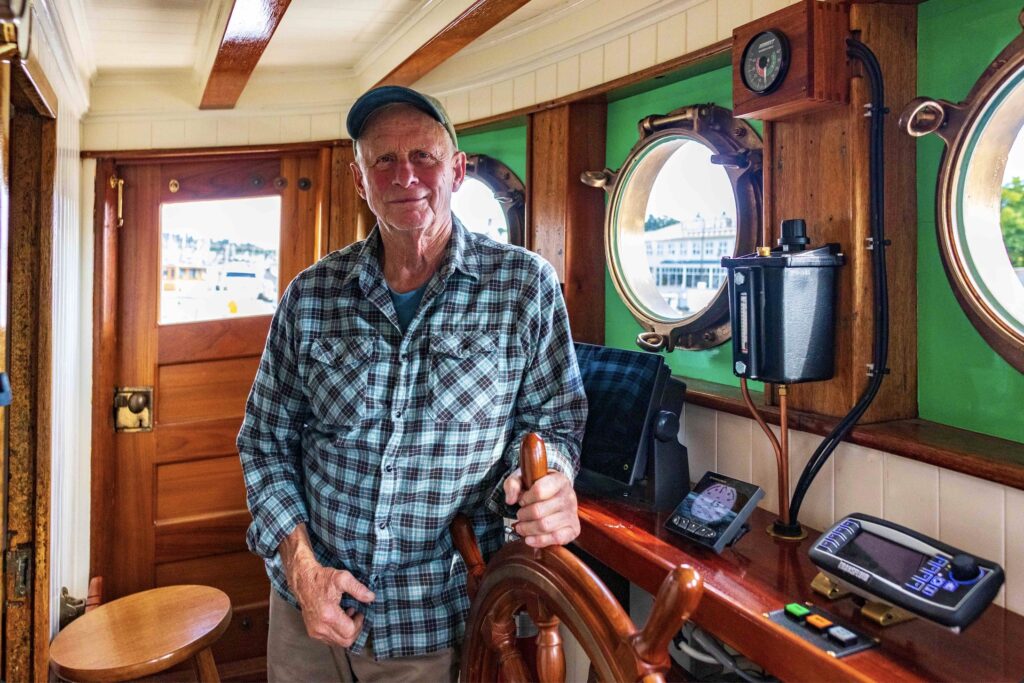
The day of the Western Flyer’s Monterey homecoming was a celebration for the hundreds of shipwrights, craftspeople, and supporters who played a part in the restoration, and for the thousands of people who lined the docks to cheer her return. But for Captain Paul Tate, the day mostly meant more work.
“I was real focused and absorbed on getting the boat in there,” he said with a laugh. “We had a lot of people on board, and all over the harbor there was this cheering, excited crowd.” He took in what he could while also doing everything necessary to dock the Flyer safely–and then spent the rest of the day helping to bring as many people on board for a tour as could be managed on a single beautiful Monterey afternoon. It wasn’t until that evening that he could take a deep breath, take a picture of the boat at dock, and think to himself, “she’s safely in Monterey…it’s the conclusion of her journey.”
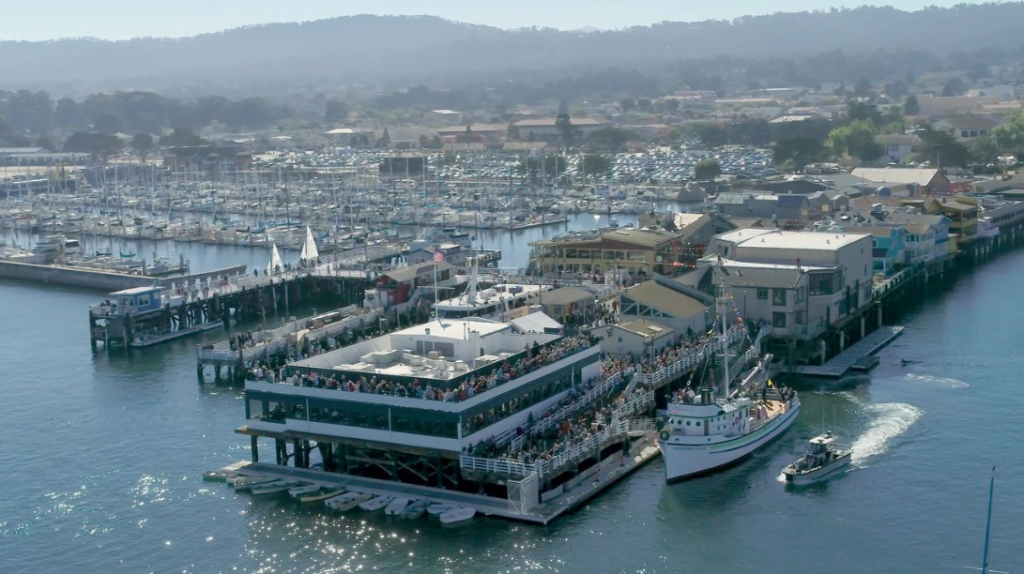
It was the conclusion of a journey for him, too. On a gray January afternoon in Moss Landing, I talked to Captain Paul about the long road that led him to be sitting drinking coffee on the Flyer’s galley benches in the deckhouse that contains more original material than any other part of the vessel (close to 90%, Paul says). Paul takes obvious pleasure in the galley’s every detail, from the fine restoration work (“You can see what’s been restored, the old striations of the grain”) to the still-disconnected diesel-oil Olympic stove discovered in the basement of a defunct Portland Montgomery Ward. As we talked, the clanging of the boatyard and a sea lion’s occasional bark came muffled through the windows.
I knew already that Paul is a deeply accomplished seaman. Trained in the Coast Guard, he’s captained vessels up and down both coasts since leaving the Guard in 1966. He’s as enthusiastic about the Flyer’s history and mission as anyone connected to the project. So, I was surprised to hear that he grew up in Pittsburgh, six or so hours from the coast. “What’s your first memory of the ocean?” I asked.
“Oh, dying to be there,” he said at once. “I remember going up to Lake Erie–Wow, this is blue! you know. But my first time at the ocean was when I was three or four. Oh, sure I can remember it.” They stayed near the shore in an old brick New Jersey beach house.
His road from inland Pennsylvania to Moss Landing wasn’t a straight one. In fact, after serving in the Coast Guard he was interested in terrestrial biology and studied Forestry at Northern Arizona University before a summer job monitoring the Alaska salmon fishery with the state Department of Fish and Game (ADF&G) converted him to ocean work. After that, he built a dizzyingly diverse resume: a degree in Fisheries Management from the University of Washington, nine years as an ADF&G biologist, then five more captaining Bering Sea crab boats. After a three-year hiatus to sail southern waters with his growing family (including several months in the Gulf of California) he turned to captaining an East Coast corporate motor yacht. He eventually heeded the persistent call of the Pacific Northwest and Alaska, refitting a Bering Sea crab boat as a research vessel, and running it on charters for a decade before landing aboard Hatfield Marine Science Center’s RV Elakha. Most recently, he spent seven years sailing the US Geological Survey RV Alaskan Gyre along the Alaska coast.
Today, living on board the Flyer in its Moss Landing berth, with a galley shelf stocked with Steinbeck and Ricketts books, Paul is both grateful and reflective. “I started living aboard when it was in the shipyard. And at night I get funny feelings, like there’s spirits here. I don’t believe in ghosts, but I do believe in spirits. And there’s essence here…” he pauses. “The souls of Ed Ricketts and John Steinbeck, all the people on board here.”
“You feel their presence?” I asked.
“Oh yeah. Yeah. All the time. I’m such a lover of John Steinbeck and his works, and–they were visionaries, as I think John [Gregg] said about them. Not caught in the past. They were seeing the change and how to educate people about interrelatedness. How everything is part of the whole, and how to study things that way. They’d rail against rapacious fishing offshore, and unfair treatment of people.”
Paul took a long pause, then a longer sip of coffee. “Anyone with an inclination towards history, literature, and the ocean would want this job,” he said. “There’s, I don’t know, a thousand people who’d feel the same way.”
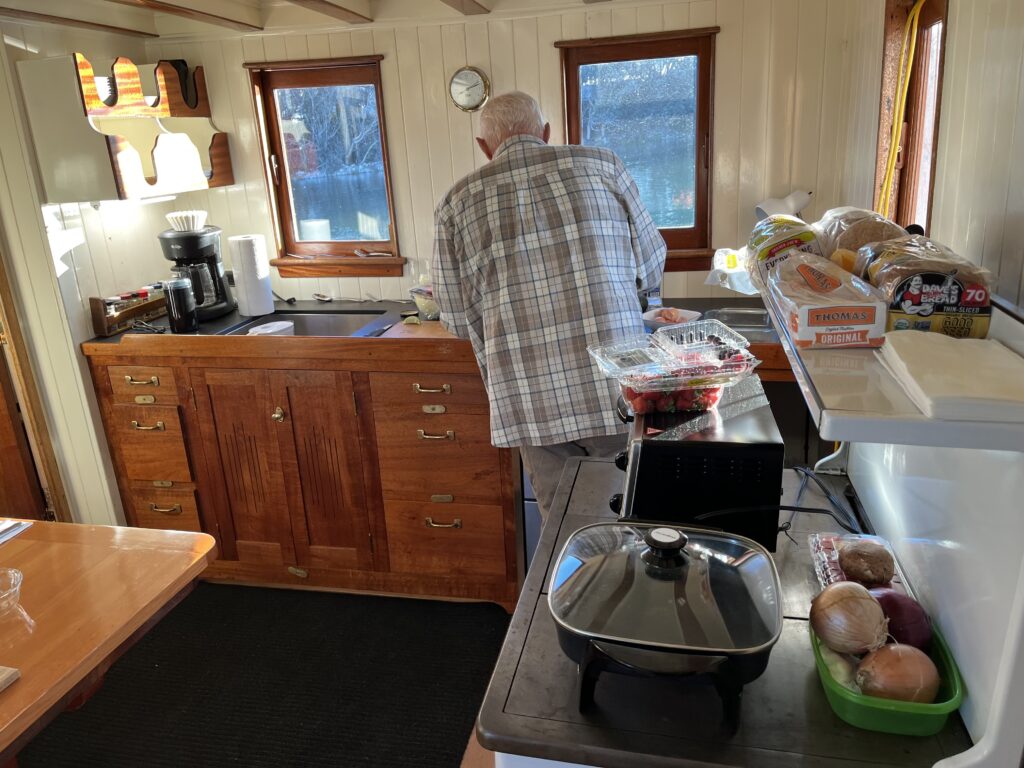
I asked Paul what he thought of the Flyer when he first saw it in November of 2022—months before he was formally hired as captain. “Just magnificent,” he says without hesitation. “You know, she was sitting there, and obviously had a long way to go to be a functional boat…but I could see the strength of her—the solidness. You know, the first time you step on a boat, and your foot hits the deck, you feel something come up from your foot and your leg and into your body. First, it’s solidness. The boat doesn’t roll, the deck doesn’t give, it doesn’t give funny sounds. It’s solid as a rock. And you walk down the deck, and you feel like, This is a world unto itself. This is what a boat should be. And you have no question in your mind at all–this is going to be a wonderful boat.”
Paul’s story reminded me of a passage from The Log from the Sea of Cortez. One of the authors (Steinbeck, I’m guessing) remembered a time that he’d seen person after person knock instinctively, almost compulsively, on the hulls of skiffs and other small boats for sale in the New York Macy’s. He was fascinated by this “unconscious testing of the hulls,” which he suspected might be rooted in something akin to race-memory. Paul, I could see, wasn’t just thinking of the hull of the Flyer but of innumerable other good old boats he’d known in his long career.
* * *
What Paul calls “this incredible year” was filled with long and laborious restoration work by a team of shipwrights, engineers, and craftspeople, all leading up to the Flyer’s return to Monterey Bay. By April, Paul had formally joined the team and was making himself available a few days a week to offer whatever input on system installation or other modifications might be useful (not much, he says modestly). And for months before the departure, he kept his eye on a calendar filling up with three conflicting tensions: the weather, paperwork, and crew.
First was the weather. “Anybody that sails in the Pacific Northwest up to Alaska knows that the equinox happens about the 20th of September when everything turns,” Paul tells me. “You start getting these massive Pacific storms mixed up with the seasonal Northwesterly winds off the North Pacific high-pressure zone and blowing down the coast. And so you have this hodgepodge of weather systems conflicting with each other.”
While waiting for the needed paperwork, the shipwrights completed the final details. Paul took the Flyer for sea trials in Lake Union. September 20–the equinox, when everything turns–came and went. At last, in October, the final papers came through; they left the same afternoon.
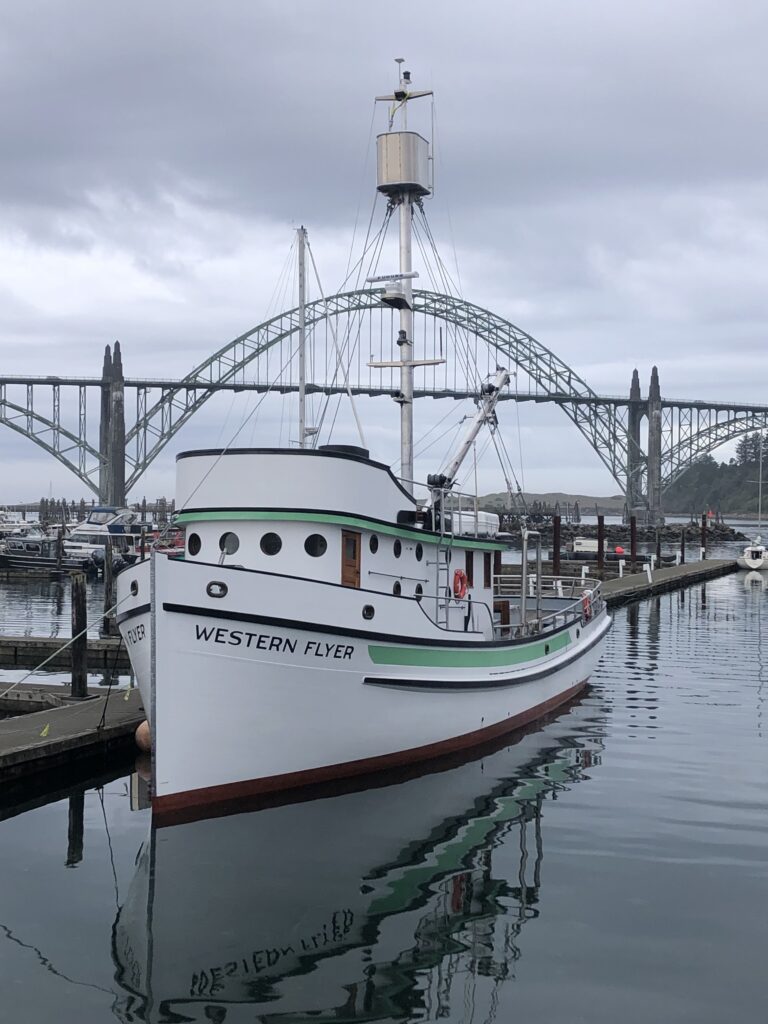
And just as Paul had feared, they’d missed the window for an easy cruise. Just a day and a half in, they were forced to put into Oregon State University’s Hatfield Marine Science Center, where they waited out the weather for three days. Less than eight hours after leaving Hatfield, they faced another storm off Cape Blanco, beating through the wrong side of a low-pressure system. Twenty-four hours after that, they were forced into the harbor by yet another system, this one pinning them down for three days.
What’s more, the frequent delays translated to losing eager crew members who were thrilled by the prospect of joining the trip down the coast but couldn’t wait out indefinite delays. “Guys can come, but then they’ve got a life,” Paul says. “You know–You’re not going tomorrow? OK, then I’ve got to get home. And the weather is stretching the whole thing out.”
The worst of the blows was off Cape Blanco. Paul is naturally cautious, but that only matters when he has good information to work with. “They missed a forecast,” he says. “Missed it by 20 knots of wind.” Where he’d expected 12-knot winds, there were 25 or even 30 (and gusts to 40); the expected three-foot seas ran nearly three times as high as predicted.
Paul shakes his head. “Cape Blanco is always a nasty place. If you’re driving down the coast, you drive out to the end of Cape Blanco, and you think you’ve stepped into a wind tunnel…afterwards, I talked to [oceanographer and Western Flyer Foundation Board President] Tom Keffer, and he said, Oh, I see what happened. You’re on the wrong side of a low—it came in tight again closer to the shore, and you were on the side of that. It was almost like disbelief for a while. He said, if you’d been another 30 or 40 miles offshore, you’d have been on the other side of it. You know how hurricanes work, they have a dangerous semicircle? We were in a dangerous semicircle, a very intense low that came up almost overnight.”
It was a rough night without much sleep, Paul says. “The boat was kind of shambled inside, stuff all over the place. A lot of rolling, rolling, and crashing into the seas.” But that’s the kind of test that every boat in the unpredictable Pacific faces sooner or later–and it was one that the Flyer easily passed. “I [already] knew how the boat handles in more moderate seasons. I really like that. And now I know she can handle the big stuff, too.”
Finally, with the weather easing and the Flyer crewed by two new sailors Paul had met during the layover in Hatfield, the way to Monterey was clear. The journey south he’d hoped to do in four days had taken more than ten.
* * *
“This incredible year,” Paul says. He takes a moment to look closely at the striations of the original deckhouse wood. “I stepped on board in late November—there it is, this incredible boat, there in the dark of the evening. And a year later, we’re sailing her into Monterey.”
“That was the most meaningful moment of all. It was! Because so many people were invested in it. We’ll do some great cruises, we’ll do some really interesting research. But nothing will compare with the boat returning to Monterey. You could tell it. You could hear it in the excitement of the people. You could feel it yourself. It wasn’t like, Oh, it’s finally happening, getting it over with. Oh no. No, it was a landmark event that I will remember all my life.”
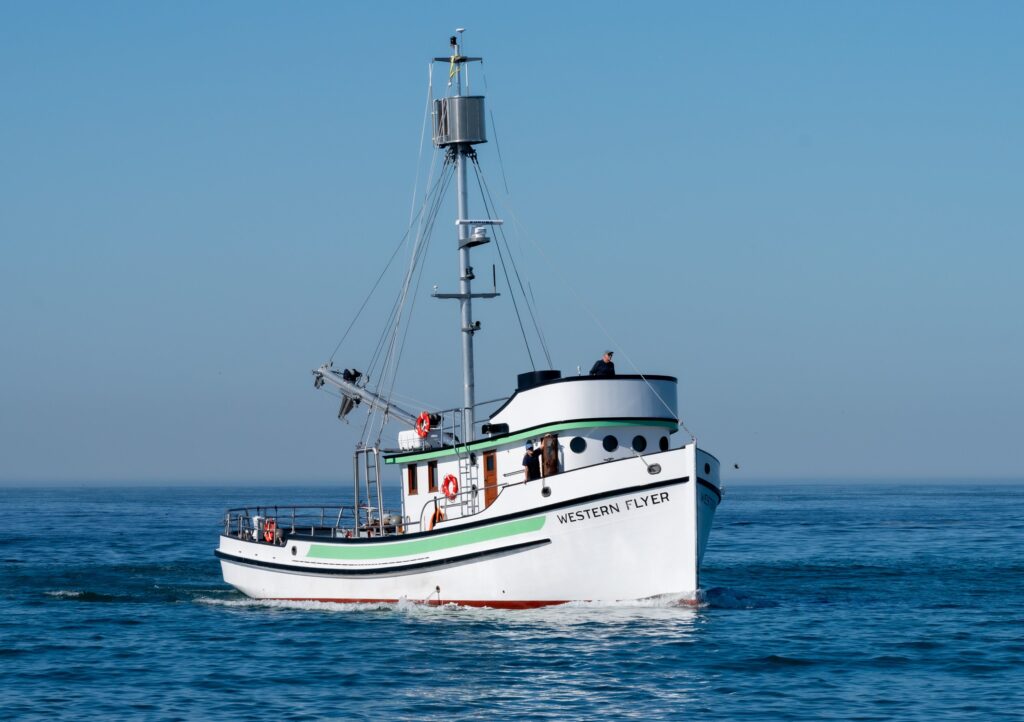
Andrew Beahrs is the author of the food history and memoir Twain’s Feast: Searching for America’s Lost Foods in the Footsteps of Samuel Clemens, and co-host with Nick Offerman of the Audible Original based on the book. His work also includes the historical novels The Windcatcher and The Sin-Eaters, as well as essays and articles for The New York Times, The Atlantic, Virginia Quarterly Review, and many other publications. Andy has been supporting the Western Flyer Foundation with fundraising and writing.
Posted in Blog